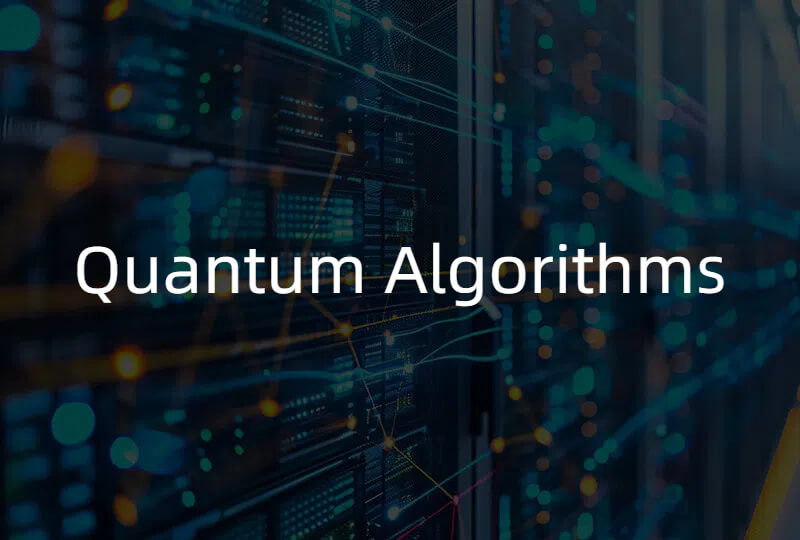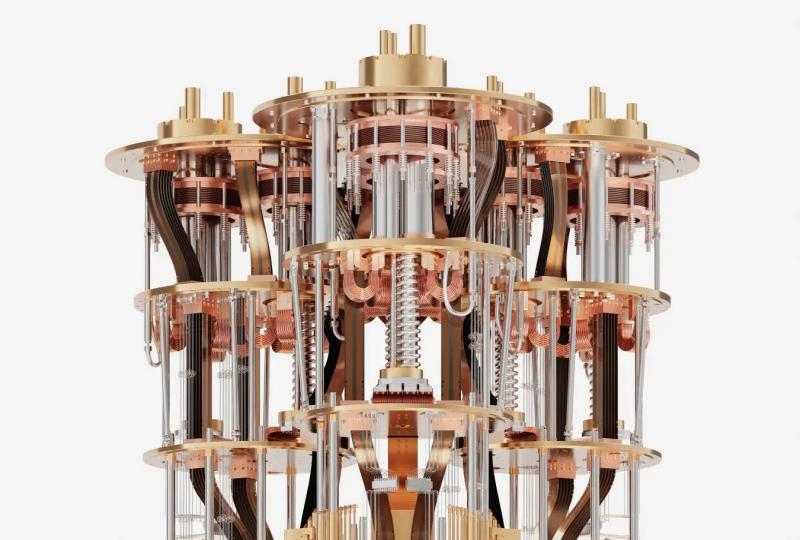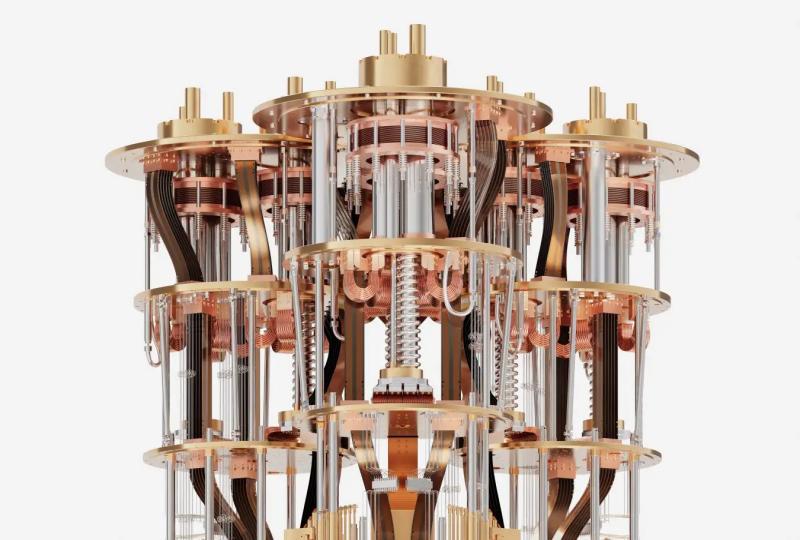Quantum Algorithms Guide: Principles, Types, and Use Cases
2025.05.27 · Blog quantum algorithmsquantum simulationquantum computer
Quantum algorithms are the heart of quantum computing. While quantum hardware determines how many qubits we can control, it's the algorithms that decide what we can actually do with those qubits. In 2025, as quantum computing companies like Google, IBM, and SpinQ push the boundaries of what quantum systems can achieve, understanding quantum algorithms has become more critical than ever.
But what exactly is a quantum algorithm, and how does it work? In this ultimate guide, we'll break down the fundamentals of quantum algorithms, explore their key types, real-world applications, the challenges they face, and where the future is headed.
Whether you're a researcher, developer, or simply curious about quantum algorithms, this full article will give you a clear and comprehensive understanding of how quantum algorithms power the next era of computing.

What Is a Quantum Algorithm?
A quantum algorithm is a step-by-step computational procedure that runs on a quantum computer, designed to take advantage of quantum phenomena like superposition, entanglement, and interference.
Unlike classical algorithms that operate on bits (0 or 1), quantum algorithms work with qubits—quantum bits that can exist in a combination of states, dramatically increasing computational flexibility.
How Do Quantum Algorithms Work?
At its core, a quantum algorithm typically consists of the following steps:
1. Initialization: Prepare qubits in a known quantum state, often starting with all qubits in the |0⟩ state.
2. Quantum Gate Operations: Apply a series of quantum gates (such as Hadamard, CNOT, and phase shift gates) to manipulate the state of qubits.
3. Interference and Entanglement: Use entanglement to correlate qubits, and interference to amplify correct outcomes while cancelling out wrong ones.
4. Measurement: Observe the quantum state, collapsing it into a classical output (0s and 1s).
What Are the Differences Between Quantum Algorithms and Classical Algorithms?
One of the key differences between quantum and classical algorithms lies in how they explore possibilities. Classical algorithms operate in a linear, step-by-step fashion. In contrast, quantum algorithms can explore multiple solutions simultaneously, thanks to the superposition of qubits. This parallelism allows certain quantum algorithms to offer exponential or quadratic speedups over the best-known classical methods.
Example: Shor's vs classical factoring
Take Shor's algorithm for factoring large numbers. While classical computers struggle with this problem (a foundation of modern encryption), Shor's algorithm can, in theory, solve it efficiently—posing both a threat and a promise.
Example: Grover's Algorithm vs Classical Search
Grover's algorithm can search unstructured data sets quadratically faster than any classical approach, showing the breadth of quantum advantage across domains.
In short, quantum algorithms are not just “faster programs.” They represent a paradigm shift in how we think about computation. And as quantum hardware steadily matures, the race to develop and implement new quantum algorithms will define who leads the next revolution in computing.
8 Key Types of Quantum Algorithms
Quantum algorithms come in many forms, each designed to solve specific categories of problems where quantum advantage is possible. Below are some of the most important and widely studied quantum algorithms in 2025. These examples show not only the range of problems quantum computers can address, but also how they outperform classical approaches.
#1 Shor's Algorithm (for Factoring Large Numbers)
Use case: Integer factorization and cryptanalysis
Developed by Peter Shor in 1994, Shor's algorithm can factor large integers exponentially faster than the best-known classical algorithms. This directly threatens modern encryption systems like RSA, which rely on the difficulty of factoring as their core security assumption.
-
Classical complexity: Sub-exponential
-
Quantum complexity: Polynomial (specifically O((log N)³))
Impact: If scalable quantum computers are built, Shor's algorithm could render current encryption schemes obsolete, driving the urgency for post-quantum cryptography.
#2 Grover's Algorithm (for Database Search)
Use case: Searching unsorted databases
Grover's algorithm provides a quadratic speedup for searching through an unstructured list. For example, if you want to find a specific item in a list of n entries, Grover's algorithm can do it in approximately √n steps.
-
Classical complexity: O(n)
-
Quantum complexity: O(√n)
Impact: Grover's algorithm isn't just useful for search—it can also accelerate optimization and solve NP-hard problems faster under certain conditions.
#3 Quantum Fourier Transform (QFT)
Use case: Period finding, signal analysis
QFT is the quantum version of the discrete Fourier transform and is an essential component in many quantum algorithms, including Shor's. It allows a quantum computer to extract periodicities from quantum states efficiently.
-
Classical complexity: O(n log n)
-
Quantum complexity: O(n²)
Impact: QFT forms the basis for solving problems like hidden subgroup detection, which appear in chemistry, number theory, and lattice cryptography.
#4 Quantum Phase Estimation (QPE)
Use case: Eigenvalue estimation, foundational to many quantum algorithms
QPE allows a quantum computer to estimate the phase (or eigenvalue) of a unitary operator with high precision. It is the foundation of algorithms for quantum chemistry, materials science, and linear algebra.
-
Often combined with QFT.
-
Crucial for algorithms like HHL (quantum linear systems algorithm).
Impact: Used in quantum simulation and energy spectrum calculations for molecules—key for drug discovery and materials design.
#5 Variational Quantum Algorithms (VQAs)
Use case: Optimization, machine learning, chemistry
VQAs are hybrid algorithms that combine classical and quantum processing. Examples include:
-
VQE (Variational Quantum Eigensolver)
-
QAOA (Quantum Approximate Optimization Algorithm)
They are well-suited for near-term noisy quantum devices (NISQ) and don't require full error correction.
Impact: VQAs make quantum computing practically useful today, enabling early applications in quantum chemistry, portfolio optimization, and AI model training.
#6 Variational Quantum Eigensolver (VQE)
Use case: Solving quantum chemistry and optimization problems
The Variational Quantum Eigensolver (VQE) is a hybrid quantum-classical algorithm designed to find the ground state energy of a Hamiltonian, which is a central task in quantum chemistry and materials science. VQE leverages a quantum processor to prepare quantum states and a classical optimizer to minimize the energy expectation value.
Algorithms like VQE use parameterized quantum circuits (also called ansätze) that can be tuned to approximate the lowest-energy solution of complex molecular systems.
Impact: VQE is one of the most promising algorithms for NISQ (Noisy Intermediate-Scale Quantum) devices, as it is resilient to certain types of noise and doesn't require full fault-tolerant quantum computing. It's already being tested for simulating small molecules and could significantly accelerate the discovery of new materials and drugs.
#7 Quantum Approximate Optimization Algorithm (QAOA)
Use case: Combinatorial optimization problems such as Max-Cut, graph coloring, scheduling, and portfolio optimization
Proposed by Edward Farhi and colleagues at MIT, the Quantum Approximate Optimization Algorithm (QAOA) is a hybrid quantum-classical algorithm designed to solve combinatorial optimization problems that are computationally hard for classical computers. It operates by alternating between quantum operations that encode a problem's cost function and mixer Hamiltonians that explore the solution space.
-
Classical alternatives: Simulated annealing, greedy heuristics, and classical approximation algorithms
-
Quantum method: QAOA uses a parametrized circuit and a classical optimizer to improve performance iteratively
Impact: QAOA is particularly promising for near-term quantum devices (NISQ era), as it is resilient to certain noise and does not require full error correction. It has demonstrated potential speedups in fields like logistics, finance, and network design. Many quantum hardware companies, including IBM and Rigetti, actively benchmark their systems using QAOA due to its practical relevance.
#8 Quantum Machine Learning (QML) Algorithms
Use case: Classification, clustering, data analysis
Quantum machine learning seeks to enhance classical ML models using quantum techniques. Algorithms include:
-
Quantum Support Vector Machines (QSVM)
-
Quantum k-means
-
Quantum Neural Networks
Impact: Potential to accelerate learning on high-dimensional datasets, though still under heavy research.
Building Blocks and Subroutines for Quantum Algorithms
While quantum algorithms like Shor's, Grover's, and VQE often take center stage, their efficiency and functionality rely heavily on a set of powerful building blocks. These subroutines are modular quantum operations used to implement or enhance larger algorithms. Understanding these components is key to appreciating how complex quantum programs are constructed.
Quantum Amplitude Amplification
Quantum Amplitude Amplification (QAA) is a general algorithmic technique that extends the principles of Grover's algorithm. It amplifies the probability amplitude of “good” states—those satisfying a specific condition—making them more likely to be measured. This mechanism lies at the heart of many quantum search and optimization algorithms and provides a foundation for achieving quadratic speedups in a range of problems.
QAA can be viewed as a meta-algorithm: rather than solving a specific task, it boosts the success probability of other quantum subroutines. It is especially valuable in noisy intermediate-scale quantum (NISQ) settings, where repeated runs are costly and unreliable.
Draper Adder
Proposed by Thomas Draper in 2000, the Draper Adder is a quantum circuit for performing addition using the Quantum Fourier Transform (QFT). Rather than working in the computational basis, it exploits the properties of the QFT to carry out arithmetic more efficiently.
This adder plays a crucial role in algorithms that require modular arithmetic, such as Shor's algorithm for integer factorization. By embedding arithmetic directly in the QFT basis, the Draper Adder reduces circuit depth and gate complexity in certain applications.
Beauregard Adder
The Beauregard Adder builds on Draper's design by offering a more compact and practical implementation for factoring and other number-theoretic quantum algorithms. It was introduced as part of a simplified version of Shor's algorithm using fewer qubits.
This adder focuses on reducing the number of quantum gates and optimizing circuit layout—important considerations for real-world quantum hardware. Although it is often used behind the scenes, its impact on the feasibility of complex algorithms like Shor's is significant.
Real-World Applications of Quantum Algorithms
#1 Drug Discovery and Molecular Simulation
Quantum Algorithms used:
-
Variational Quantum Eigensolver (VQE)
-
Quantum Phase Estimation (QPE)
Problem: Simulating the exact behavior of molecules and predicting how they interact is computationally intractable on classical computers for anything beyond simple systems.
Quantum Advantage: Quantum algorithms like VQE can model molecular structures and chemical reactions more accurately and efficiently—helping pharmaceutical companies shorten development cycles and reduce costs.
Real-world examples:
Roche and Biogen are partnering with quantum computing firms to accelerate molecular simulations.
#2 Finance and Portfolio Optimization
Quantum Algorithms used:
-
Quantum Approximate Optimization Algorithm (QAOA)
-
Grover's Algorithm
-
Quantum Machine Learning models
Problem: Portfolio optimization and risk analysis involve huge combinatorial spaces, especially with constraints like market volatility, regulatory limits, and asset correlations.
Quantum Advantage: QAOA can tackle these complex optimization problems with fewer iterations. Quantum-enhanced ML can help detect patterns in high-dimensional financial data faster.
Real-world examples:
-
JPMorgan Chase has been experimenting with QAOA for option pricing and asset optimization.
-
Quantum startups are working on credit scoring, fraud detection, and risk modeling.
#3 Artificial Intelligence and Machine Learning
Quantum Algorithms used:
-
Quantum Neural Networks
-
Quantum Support Vector Machines (QSVM)
Problem: Classical AI models can struggle with high-dimensional data or non-convex landscapes.
Quantum Advantage: Quantum algorithms can process large feature spaces in parallel, offering new ways to build classifiers, perform clustering, and optimize deep learning models.
Real-world examples:
Top quantum computing companies like Google, IBM, and SpinQ are exploring quantum-enhanced AI for natural language processing, recommender systems, and AI-based search engines.
#4 Logistics and Supply Chain Optimization
Quantum Algorithms used:
-
QAOA
-
Quantum annealing (used by D-Wave)
Problem: Tasks like route optimization, scheduling, and inventory planning are classic NP-hard problems.
Quantum Advantage: Quantum algorithms can significantly reduce solution time, especially for multi-constraint scenarios involving thousands of variables.
Real-world examples:
-
Volkswagen tested quantum route optimization to reduce traffic congestion.
-
Airbus and FedEx are exploring supply chain optimization with quantum partners.
#5 Materials Science and Battery Design
Quantum Algorithms used:
-
Quantum Phase Estimation
-
VQE
Problem: Understanding the behavior of materials at atomic and subatomic levels requires simulation of quantum interactions.
Quantum Advantage: Quantum algorithms can help design new materials, such as superconductors, alloys, and next-generation batteries (e.g. solid-state lithium batteries).
Real-world examples:
IBM and Mercedes-Benz are using quantum computers to simulate lithium oxide molecules for battery research.
Challenges and Limitations of Quantum Algorithms
#1 Hardware Constraints: Qubit Count, Fidelity, and Decoherence
Quantum algorithms typically require a significant number of qubits with high fidelity and long coherence times. However, today's quantum hardware remains limited:
-
Qubit counts are still in the range of tens to a few hundred, far below what is required for many complex algorithms.
-
Gate fidelities are imperfect, leading to high error rates during computations.
-
Short coherence times result in fragile quantum states that cannot persist long enough for deep circuits to complete.
These limitations make it difficult to implement complex quantum algorithms, especially those that require quantum error correction or deep quantum circuits.
#2 Scalability of Quantum Algorithms
While several quantum algorithms offer theoretical advantages, their scalability is often a challenge:
-
Algorithms like Shor's and Grover's demonstrate quantum speedups, but scaling them to practical, large-scale problems remains difficult.
-
Many quantum algorithms require exponentially increasing resources (e.g., logical qubits, circuit depth) as problem size grows.
-
There is a lack of general-purpose, scalable quantum algorithms equivalent to what deep learning is for classical AI.
As a result, much of the algorithmic research remains confined to academic settings or toy problems with limited real-world relevance.
#3 The NISQ–Fault-Tolerant Gap
We currently live in the era of Noisy Intermediate-Scale Quantum (NISQ) devices, which poses unique challenges:
-
NISQ systems have enough qubits to perform non-trivial computations but lack quantum error correction.
-
Many powerful algorithms (e.g., Shor's) require fault-tolerant quantum computing, which is still years away.
-
The algorithms compatible with NISQ devices, such as Variational Quantum Eigensolver (VQE) and Quantum Approximate Optimization Algorithm (QAOA), have limited performance and scope.
This gap between what we can currently run and what is theoretically possible remains one of the biggest obstacles in realizing the full potential of quantum algorithms.
#4 Research-Grade vs. Commercial-Grade Algorithms
Most existing quantum algorithms are still in the research or experimental phase:
-
Algorithms often lack robustness, practical data input/output handling, and integration into classical workflows.
-
Commercial use cases demand reliable, repeatable performance, which is still difficult to achieve with existing quantum solutions.
-
Many quantum advantages are theoretical or simulated, and have yet to be demonstrated at scale on physical hardware.
This mismatch between research outcomes and commercial needs highlights the ongoing work required before quantum algorithms can be routinely deployed in industry.
Future of Quantum Algorithms
As quantum computing steadily progresses from theoretical research to practical implementation, the future of quantum algorithms is becoming increasingly dynamic. Advancements in programming frameworks drive this evolution, the emergence of hybrid algorithmic paradigms, and the expanding intersection between quantum computing and fields such as AI and the Internet of Things (IoT).
#1 Growth of Quantum Programming Languages and Toolkits
To make quantum algorithm development more accessible, several open-source quantum programming frameworks have been introduced. These tools allow researchers and developers to design, simulate, and run quantum algorithms across different hardware backends.
-
Qiskit (developed by IBM): A widely adopted Python-based SDK offering tools for quantum circuit design, simulation, and execution on IBM Quantum hardware.
-
Cirq (developed by Google): A lightweight library for building and optimizing quantum circuits specifically for Noisy Intermediate-Scale Quantum (NISQ) devices.
-
PennyLane (by Xanadu): A powerful tool focused on quantum machine learning, supporting hybrid quantum-classical workflows and integrating well with PyTorch and TensorFlow.
-
SpinQit (by SpinQ): It supports quantum programming based on Python, provides users with rich quantum algorithm interfaces, supports cross-platform execution, and realizes connection with quantum computers, quantum simulators, and the SpinQ cloud platform.
These platforms are laying the foundation for a robust software ecosystem, enabling more researchers, developers, and engineers to experiment with and contribute to quantum algorithm development.
#2 Emerging Trends in Quantum Algorithm Research
While foundational algorithms like Shor's and Grover's remain benchmarks, the future lies in novel, domain-specific, and hybrid algorithms tailored for near-term quantum devices.
Key trends include:
-
Hybrid quantum-classical algorithms: Combining classical processing with quantum subroutines (e.g., VQE, QAOA) to optimize tasks like energy minimization and combinatorial optimization in the NISQ era.
-
Quantum accelerators: Specialized quantum components integrated into classical HPC systems to act as co-processors for specific workloads, such as matrix inversion, feature mapping, or Monte Carlo sampling.
-
Application-centric design: Algorithms are being designed with specific industry use cases in mind — finance, materials science, drug discovery, and logistics.
As the field matures, we anticipate a shift from general-purpose quantum speedups to targeted quantum advantage in high-value applications.
#3 Integration with Artificial Intelligence and IoT
Quantum computing is expected to complement and amplify emerging technologies such as AI and IoT in transformative ways:
Quantum AI
-
Quantum machine learning algorithms can accelerate model training, enable more efficient feature extraction, and handle high-dimensional data.
-
Tools like PennyLane and TensorFlow Quantum are leading research into quantum-enhanced neural networks, kernel methods, and generative models.
Quantum IoT (QIoT)
-
Future IoT networks, particularly in critical infrastructure and defense, may benefit from quantum-enhanced security protocols, such as quantum key distribution (QKD).
-
Quantum algorithms may assist in real-time edge analytics and anomaly detection in decentralized, sensor-rich environments.
Together, these integrations hint at a future where quantum algorithms are not standalone innovations, but embedded in broader technological ecosystems.
FAQs
How many quantum algorithms exist?
As of 2025, there are dozens of well-documented quantum algorithms, each targeting specific problem classes—such as Shor's for factoring, Grover's for search, VQE and QAOA for optimization, and many more. Beyond these core examples, researchers are actively exploring hundreds of algorithmic variants and subroutines, especially in areas like quantum machine learning and quantum simulation.
What was the first quantum computer algorithm?
The first recognized quantum algorithm was Deutsch's algorithm, proposed in 1985. It demonstrated that a quantum computer could solve certain problems more efficiently than a classical computer—even with just a single qubit—laying the groundwork for more powerful algorithms like Deutsch–Jozsa, Shor's, and Grover's that followed in the 1990s.
What is the fastest quantum algorithm?
It depends on how “fastest” is defined. In terms of asymptotic speedup over classical algorithms, Shor's algorithm is one of the fastest—it can factor large integers in polynomial time, while the best-known classical methods take superpolynomial time. Another contender is Grover's algorithm, which provides a quadratic speedup for unstructured search problems. While not exponential, Grover's advantage applies broadly and is optimal for its class.
In short:
-
Shor's offers exponential speedup for factoring
-
Grover's gives quadratic speedup for general search
Both are considered among the “fastest” depending on context and problem type.
Featured Content






